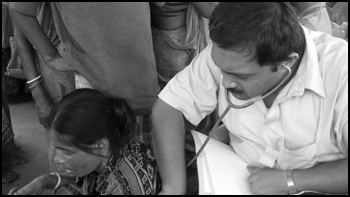Welcome to Kemex2012. An endeavor in disaster preparedness for the city of Kolkata.
Disasters are becoming more and more frequent and claiming more lives as we progress in the twenty first century. Stephen House, Cyclone Ayla, AMRI fire, North Bengal earthquakes, Saithia rail  incidents,examples abound. Our city by the eastern bank of Hooghly river falls in seismic zone3,it has a lot of old dilapidated buildings, stockyards full of potentially inflammable materials in densely populated areas. Add to this illegal constructions, flouting of fire and civic norms,lack of structural mitigation measures,the nightmare takes shape. During the Pujas and other such holidays the population of the city goes up to 10 times the normal. All the buses are crowded and a journey of 3 km can take 2 hours. Just shut your eyes and think of a mass casualty incident in 3 Puja pandals like the London Tube incident. The mayhem, the stampede, the chaos… incidents,examples abound. Our city by the eastern bank of Hooghly river falls in seismic zone3,it has a lot of old dilapidated buildings, stockyards full of potentially inflammable materials in densely populated areas. Add to this illegal constructions, flouting of fire and civic norms,lack of structural mitigation measures,the nightmare takes shape. During the Pujas and other such holidays the population of the city goes up to 10 times the normal. All the buses are crowded and a journey of 3 km can take 2 hours. Just shut your eyes and think of a mass casualty incident in 3 Puja pandals like the London Tube incident. The mayhem, the stampede, the chaos…
Are we ready?
The healthcare sector is not prepared to combat disasters. The hospitals do not have a plan validated by repeated drills and audits, even if they do have a plan the employees are barely aware, neighboring healthcare institutions do not have a MOU regarding disaster response and they are almost never integrated with other stakeholders. The accreditation measures (NABH,JCI)and legal bindings including clinical establishment act, fire services act etc. provide some carrot or stick to facilitate the planning and preparedness activities but once the inspections are over the plans lie in dusty cabinets, drills seldom happen and even when they happen they are never monitored and evaluated by external agencies, no drill tool appropriate to the Indian scenario is available, structural preparedness measures are very rarely undertaken unless they are legally enforced.
The pre-hospital care situation is even worse. The first responders are not trained in basic trauma life support, frequently spinal injuries happen during extrication, CPR is rarely provided.
Lives are lost and people lose use of their limbs,voices or end up brain dead.
The mass gathering areas, schools, colleges, hotels, shopping malls, railway stations, Puja committees do not have an all hazard plan tested by drills and audits , nor are their staffs trained to handle such mass casualty incidents.
Whatever preparedness measures are there exist in pockets, the community does not have an integrated all hazard plan involving all the stake holders; the first responders,police,fire fighters, ambulances, Government and private hospitals etc. During disaster people are evacuated by lay public later by the police or the fire services, but they need training to medically stabilize the people they rescued. The situation is grim, as evidenced by the outcome of the recent disasters.
Now is the time we define who does what , when, how soon, for whom & where in case of disasters and mass casualty incidents across all the sectors of the entire city, we need to understand what is already there & what is not, perform gap analysis, augment what already exists, understand training needs, train and develop what is needed and move forward. Kemex with the support of the government and the partners aims to do so.
|